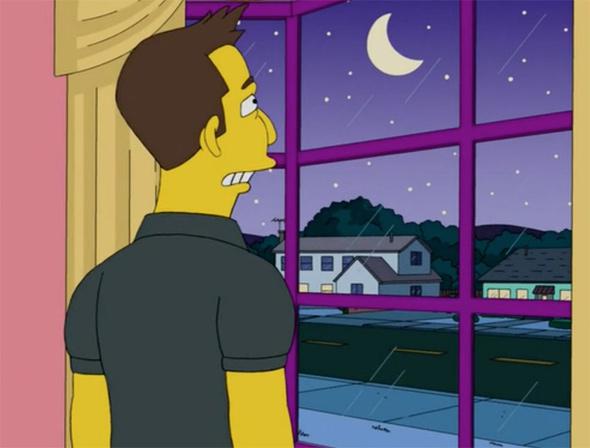nothing really, except that the crescent is facing the wrong way.
though few people can say which way the crescent moon should be facing
they have a visceral feeling that this isn't right.
when the moon is a thin crescent, it means that the sun is illuminating the side which is not facing us, so the moon has to appear very close to the sun in the sky: the crescent moon is seen just after sunset or just before sunrise, with the crescent facing down at the sun below the horizon (tips pointing up). in the northern hemisphere it points down and to the right at sunset (looking west with sun setting in the southwest).
you morning people may know that the crescent lies down and to the left in the east.
it's the opposite in the southern hemisphere.
OK that was really confusing
here's a better description.
for bad astronomy blogger Phil Plait, this knowledge turned his world upside down
DOH!
he concluded that springfield must actually be in the southern hemisphere based on this scene from the elon musk episode of the simpsons.
the only way the crescent can be on the top of the moon is if you're standing on your head, or in outer space where up and down doesn't matter. or perhaps some strange partial lunar eclipse.
i chose this orientation as the unnatural rotation gives it a spacey feel
kubrick was well aware of this:

by the way, here's one of the most over-the-top analyses of a movie i've ever seen
tons of fun
but for the clouds you may see the crescent moon in the next few nights
take a look and see what's missing from my image
to be continued...
-bill w
Technical notes:
web cam, DMK 51 and the tiny tak, Takahashi FS-60C, 60 mm aperture at f/4.2 with a reducer. The field of view is approximately 96x72 arc minutes. Each image is a one minute video capture at approximately 12 fps, aligned in autostakkert, wavelets in registax.
he concluded that springfield must actually be in the southern hemisphere based on this scene from the elon musk episode of the simpsons.
the only way the crescent can be on the top of the moon is if you're standing on your head, or in outer space where up and down doesn't matter. or perhaps some strange partial lunar eclipse.
i chose this orientation as the unnatural rotation gives it a spacey feel
kubrick was well aware of this:
by the way, here's one of the most over-the-top analyses of a movie i've ever seen
tons of fun
but for the clouds you may see the crescent moon in the next few nights
take a look and see what's missing from my image
to be continued...
-bill w
Technical notes:
web cam, DMK 51 and the tiny tak, Takahashi FS-60C, 60 mm aperture at f/4.2 with a reducer. The field of view is approximately 96x72 arc minutes. Each image is a one minute video capture at approximately 12 fps, aligned in autostakkert, wavelets in registax.
